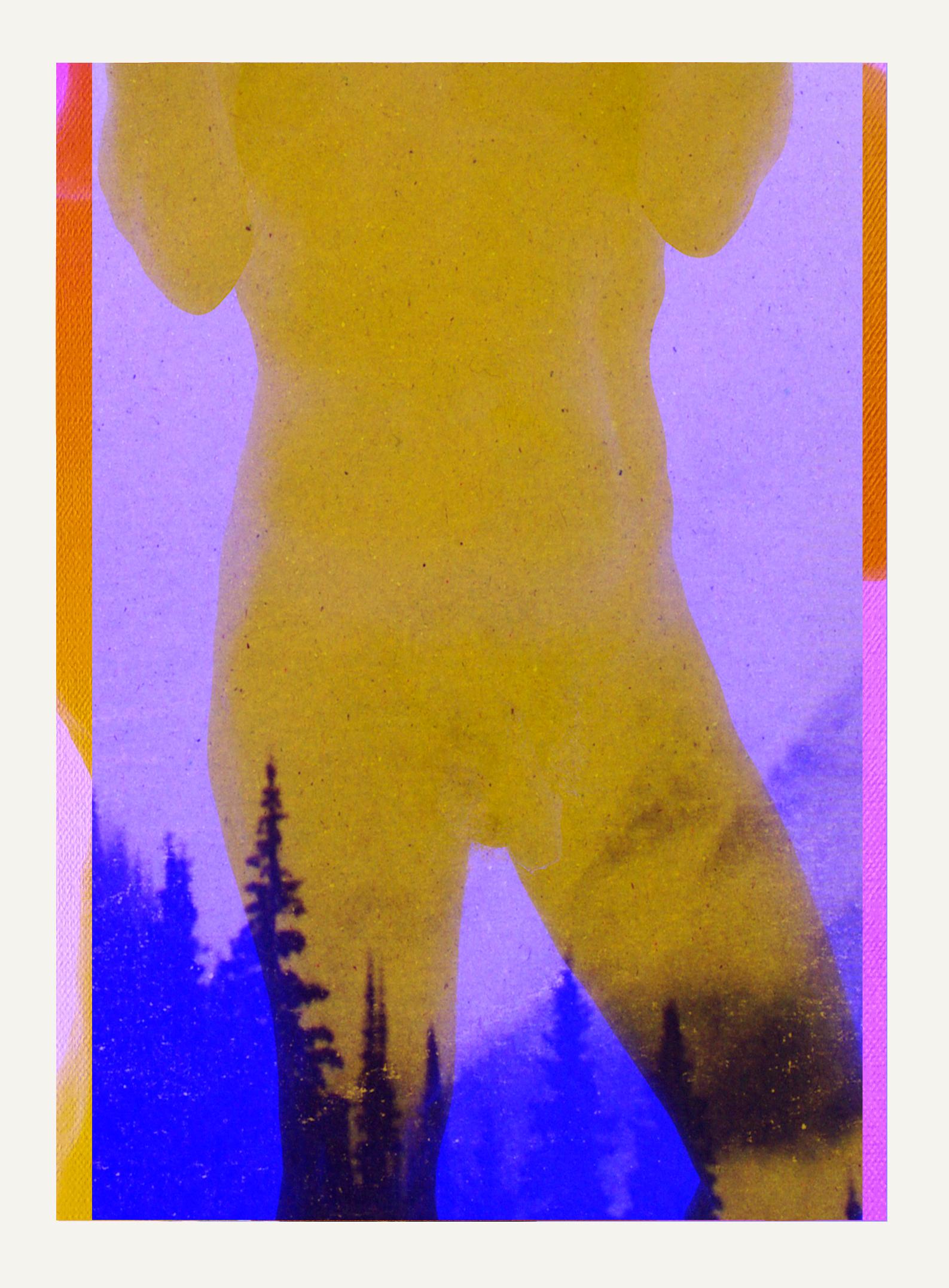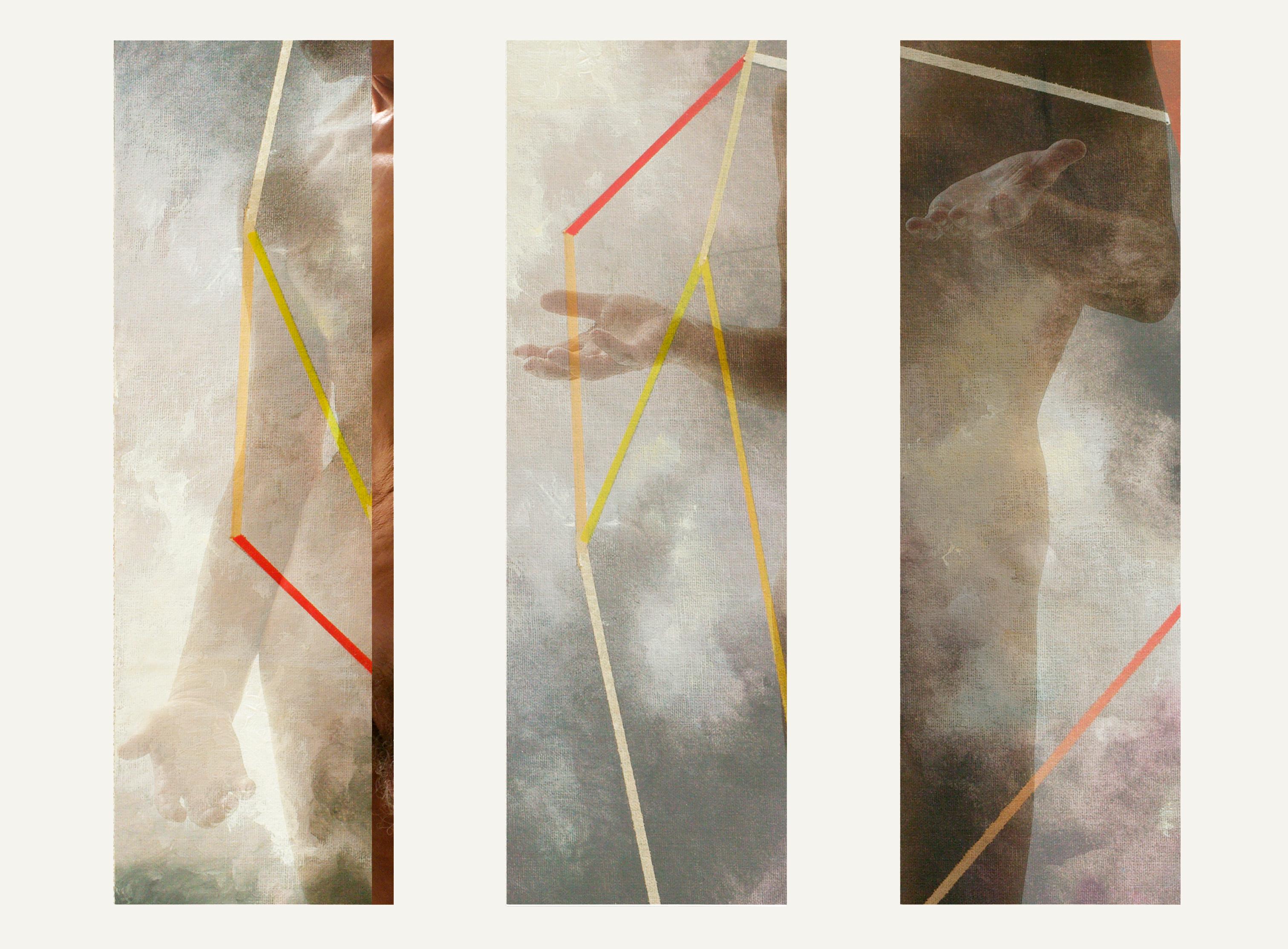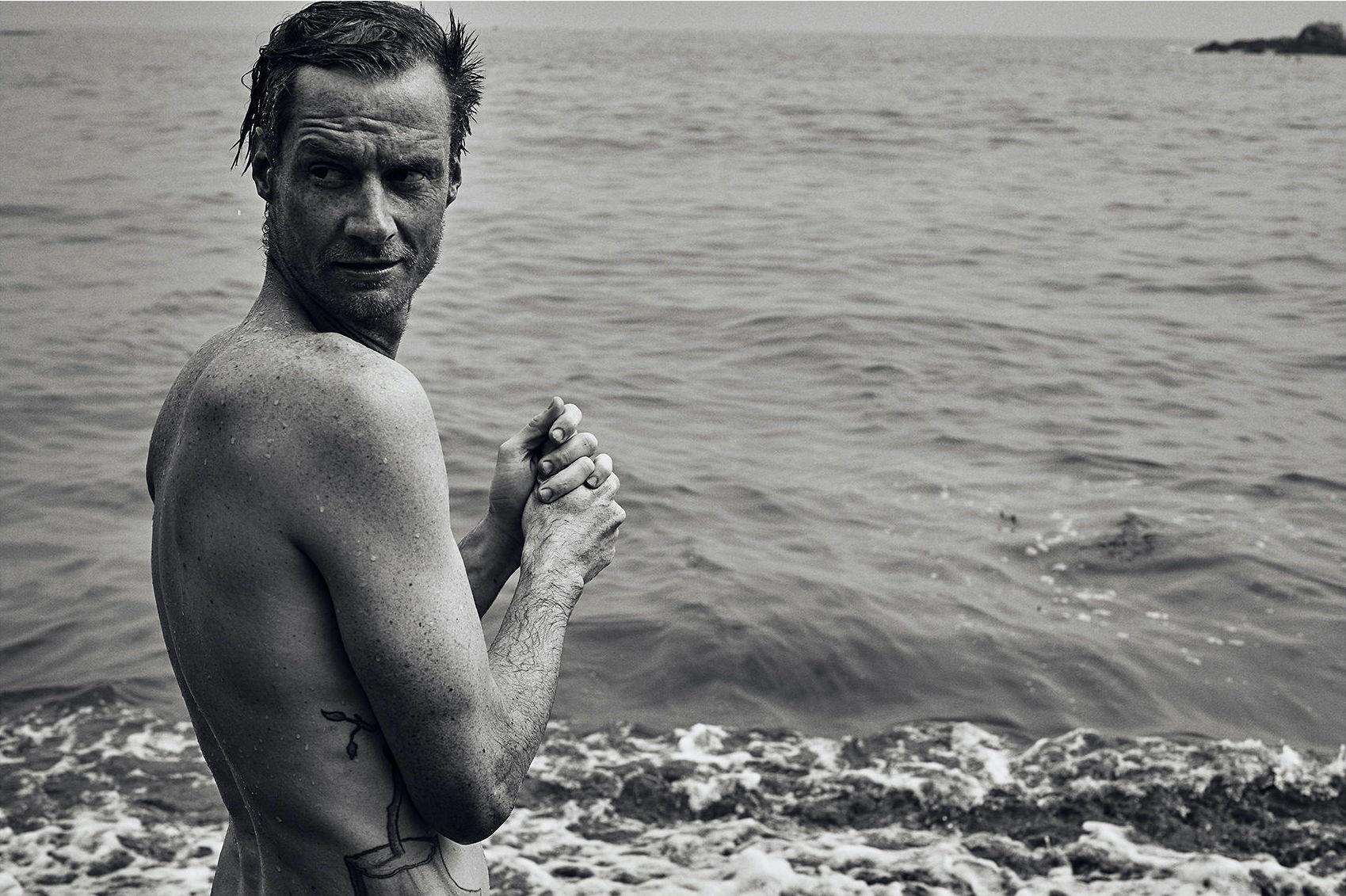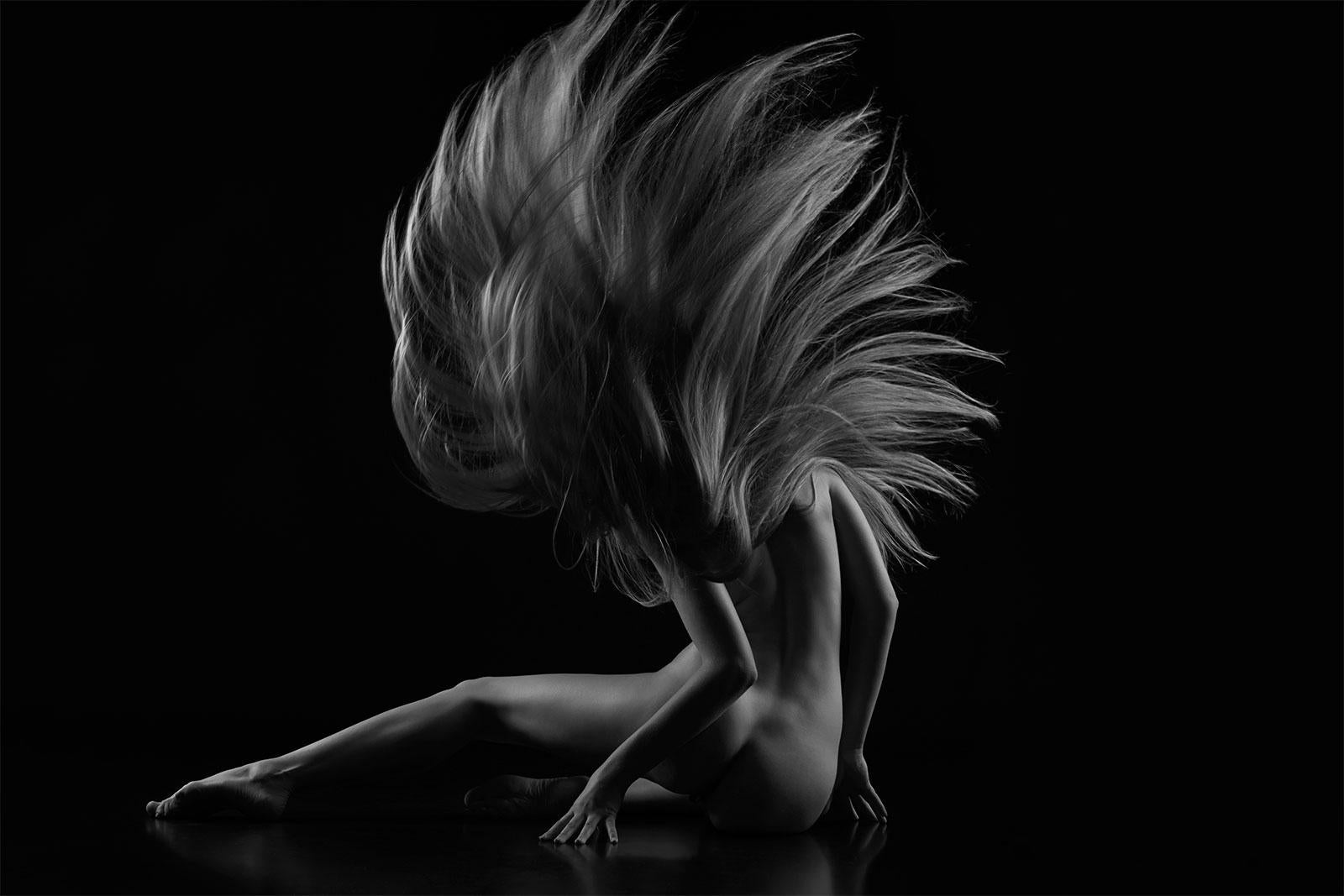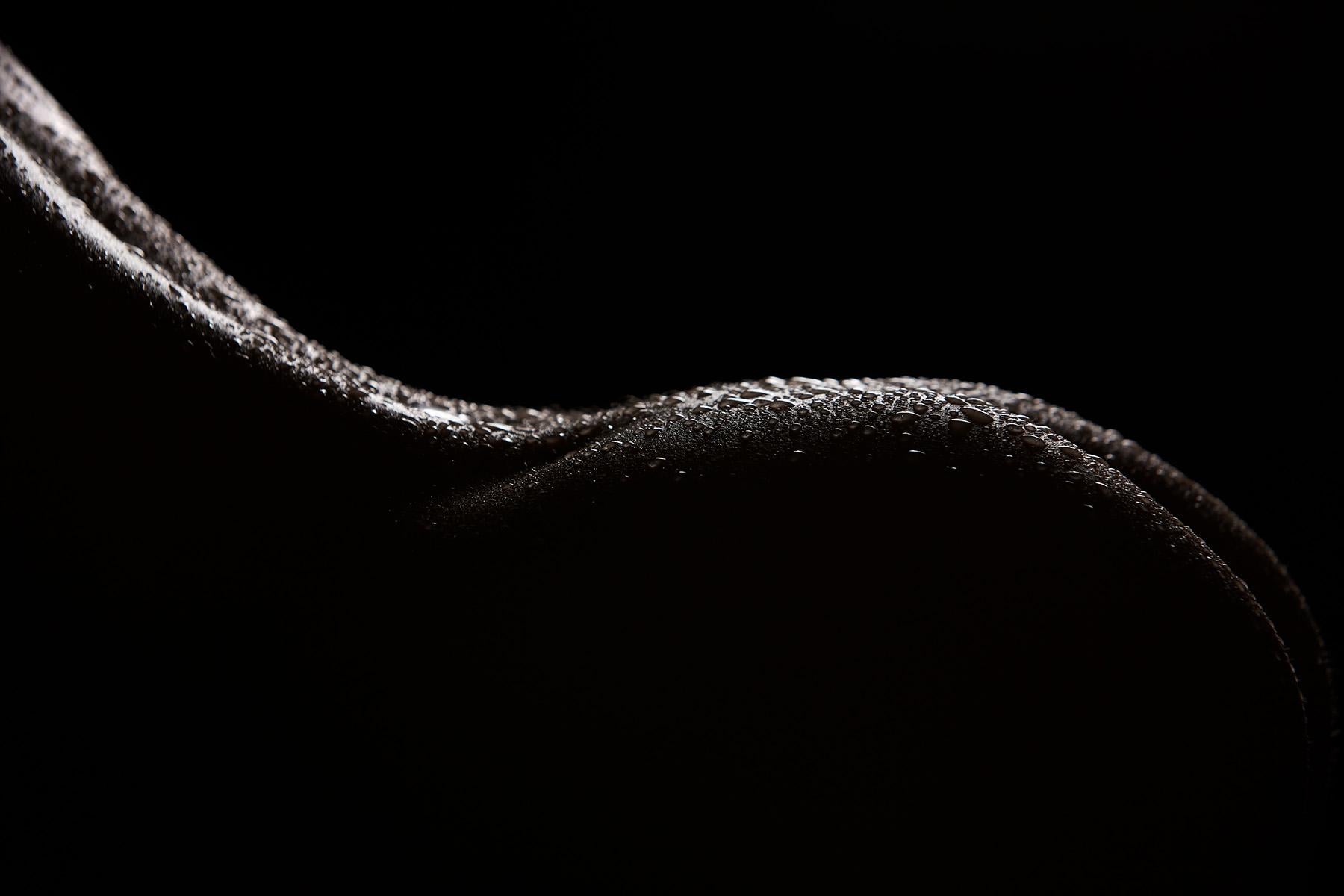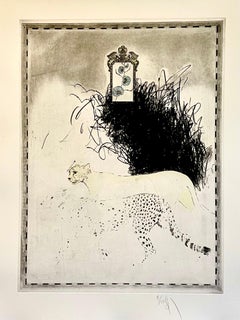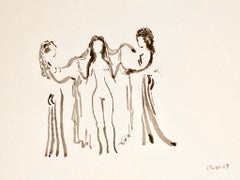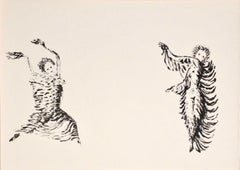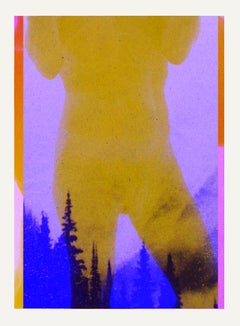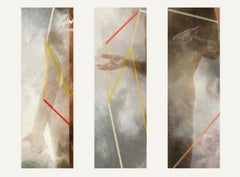Erotic Etching from Le Satyricon
Want more images or videos?
Request additional images or videos from the seller
1 of 8
André DerainErotic Etching from Le Satyricon
About the Item
- Creator:André Derain (1880-1954, French)
- Dimensions:Height: 17.5 in (44.45 cm)Width: 13.25 in (33.66 cm)
- Period:
- Condition:
- Gallery Location:Surfside, FL
- Reference Number:1stDibs: LU382630872
About the Seller
4.9
Platinum Seller
These expertly vetted sellers are 1stDibs' most experienced sellers and are rated highest by our customers.
Established in 1995
1stDibs seller since 2014
1,541 sales on 1stDibs
Typical response time: 1 hour
More From This SellerView All
- Large Donald Saff Surrealist Pop Art Aquatint Etching Leopard Cheetah Big CatsBy Donald SaffLocated in Surfside, FLArtist: Donald Saff Title: Leopard or Cheetah, big cats in interior Year: 1980 Medium: Etching with Aquatint, Hand signed and numbered in pencil Edition: 150 30 in. x 22.5 in. (76.2 cm x 55.88 cm) Donald Jay Saff (born 12 December 1937) is an artist, art historian, educator, and lecturer, specializing in the fields of contemporary art in addition to American and English horology. Saff was born in Brooklyn, New York. Donald Saff began his undergraduate degree at Queens College, City University of New York, in 1955, initially envisioning a career as an electrical engineer. However, the following year Saff changed his major to art and learned printmaking, to graduate with a B.A. in 1959 and a M.A. in art history from Columbia University in 1960. In the years following, Saff was awarded a M.F.A. from Pratt Institute in 1962 and an Ed.D. in studio art and art history from Columbia University in 1964. In his early career, Saff studied with Robert Goldwater, Robert Branner, Louis Hechenbleikner, and Meyer Schapiro. Saff is primarily known for his work and collaboration with the leading artists of the late-twentieth century, including Robert Rauschenberg, Jim Dine, Roy Lichtenstein, James Rosenquist, Nancy Graves, Philip Pearlstein, and James Turrell. Saff's prolific career is the subject of Marilyn S. Kushner's book, Donald Saff: Art in Collaboration (2010). Saff began his teaching career at Queens College as a lecturer in Art History, Design, and Drawing, from 1961 to 1964. In 1965, Saff was appointed as an associate professor in the visual arts department of the University of South Florida in Tampa, Florida, and became professor and chairman of the visual arts department two years later. In 1971, Saff became the founding dean of the College of Fine Arts at U.S.F., and was awarded the rank of distinguished professor at the university in 1982. Saff was later named dean emeritus by USF in 1989, and distinguished professor emeritus in 1996. In 1999, Saff was awarded the honorary degree of Doctor of Fine Arts at U.S.F. He was appointed the Director of Capital Projects of the Solomon R. Guggenheim Foundation, New York, in 2001, followed by the appointment of Senior Curator of Prints and Drawings in 2002. In 1968, Saff founded Graphicstudio at U.S.F. through funding by a seed grant from the Florida Arts Council and community supporters; the following year, Philip Pearlstein was the first artist invited to Graphicstudio to collaborate with Saff and his team. Saff became Founding Dean of the College of Fine Arts at U.S.F. in 1971. Under Saff's directorship, Graphicstudio collaborated with artists such as James Rosenquist, Robert Rauschenberg, Richard Anuszkiewicz, Shusaku Arakawa, Jim Dine, Lee Friedlander, Nancy Graves, Ed Ruscha, and Roy Lichtenstein. The collection of Graphicstudio is archived in the National Gallery of Art in Washington, D.C. Graphicstudio was founded by Dr. Donald Saff as part of the renaissance in American printmaking in the 1960s, in the company of studios such as ULAE, Tamarind, and Gemini GEL. This renaissance brought artists involved in the Pop art movement, such as Robert Rauschenberg, James Rosenquist, and Jim Dine, together with a growing number of trained printmakers from around the world. After Saff retired from U.S.F., he continued to collaborate with these artists, as well as James Turrell, at Saff Tech Arts in Oxford, Maryland, which was established in 1991. While Saff and Rauschenberg were traveling in China, Rauschenberg conceived of the Rauschenberg Overseas Culture Interchange (ROCI) in 1982, which began in 1984 with Saff as the artistic director. Saff travelled to over twenty countries and met with poets and writers in order to decide which were the most appropriate venues for the show and prepare for Rauschenberg's visit and exhibition. In recent years, Saff has continued to lecture and write on art and the history and mechanics of nineteenth-century clocks; in particular, the work of Charles Fasoldt, in addition to the development of time distribution from the Harvard College Observatory, and the horological innovations of Richard F. Bond. He has lectured on Fasoldt for the Antiquarian Horological Association in Cincinnati, OH (2001), the National Association of Watch and Clock Collectors in Pittsburgh, PA, and Anheim, CA (2003), and at the 26th Annual Ward Francillon Time Symposium in Houston, TX (2004), among other venues. Saff continues to work with the Royal Observatory in Greenwich, collaborating with Jonathan Betts and Rory McEvoy, on the trials of Burgess Clock B. (See "Honors.") Exhibitions Saff's individual work spans across his career of collaborative art. As early as 1965, Saff produced Duino Elegies, a print suite that was published and exhibited by Martin Gordon Gallery in New York and at the Galleria Academia in Rome; it was acquired by the Library of Congress, the Brooklyn Museum, and Lessing Rosenwald. Saff also collaborated with printers Galli and Arduini in Urbino to create print suites Breezes (1969), exhibited and published by the Martin Gordon Gallery. Additionally, Saff collaborated with Galli on print suites Paradise Lost (1970) and Numbers (1972), the former printed in Tampa, FL, and exhibited at the Martin Gordon Gallery, the University of South Florida Gallery, the Toronto Art Gallery, and the Loch Haven Art Center, FL. Numbers was exhibited at Multiples Gallery, New York. In 1979, Saff produced print suite Fables that was published and exhibited by the Getler/Pall Gallery in New York, followed by the print suite Constellations (1980), which was also exhibited at the Tom Lutrell Gallery in San Francisco. In 1981, Saff had solo exhibitions of his artwork in the Galleria d'Arte Moderna in Udine, Italy, Youngstown State University, OH, the Leo Castelli Gallery, NY, and in "Recent Acquisitions" at The Museum of Modern Art, NY. Additionally, Saff had solo exhibitions at Dyansen Gallery, NY (1982), at I. Feldman Gallery, Sarasota (1983), and at Edison Community College, FL (1988). In 1989, the retrospective Donald Saff: Mixed Metaphors, 1956–1989 was held at the Tampa Museum of Art and traveled to the Virginia Beach Center for the Arts, followed by his solo exhibition Winged Metaphors: Sculpture and Prints by Donald Saff at the Barbara Gillman Gallery in Miami later that year. In 1997, Brenau University Galleries exhibits Poetics: The Work of Donald Saff in Gainesville, GA. The same year, the Tampa Museum of Art exhibited Donald Saff/Robert Rauschenberg: In Collaboration. Finally, the Academy Art Museum in Easton, MD, exhibited Donald Saff: Gravity and Constellations; Selected Works in 2006. Honors Saff was awarded a Teaching Fellowship at Queens College (1960), a Yaddo Fellowship, Saratoga Springs, NY (1963), and Fulbright Fellowship (1964) to Italy where he studied at Istituto Statale di Belle Arti. While in Urbino, Saff met lifelong friend and colleague Deli Sacilotto, with whom he would co-author Printmaking: History and Process (1978) and Screenprinting: History and Process (1979). He received the Governor's Award for the Arts from the State of Florida in 1973, and was awarded the Florida Endowment for the Arts Individual Artist Grant in 1980. In 1997, Saff was awarded the title "Printmaker Emeritus" by the 25th Southern Graphics Council Conference in Tampa, F.L. In 2002, he was appointed as Visiting Distinguished Professor of Rhode Island School of Design. In April 2015, Saff was awarded a certificate from the Guinness World Records for his work on completing the world's most accurate pendulum clock, "Clock B", which was started by Martin Burgess in 1975. The official title awarded by Guinness World Records, as "the most accurate mechanical clock with a pendulum...Category
1980s Pop Art Figurative Prints
MaterialsEtching, Aquatint
- Apeles Fenosa Spanish Sculptor Mourlot Lithograph Abstract Expressionist FiguresBy Apelles FenosaLocated in Surfside, FLThis is from a hand signed, limited edition (edition of 125) folio or full page lithographs some having a poem verso. The individual sheets are not signed or numbered. This listing is just for the one sheet, not for the cover sheet or the signed sheet. This was printed at Mourlot in Paris, France, on velin D'Arches paper. Apel les Fenosa i Florensa (1899 - 1989) lived in Spain. Apelles Fenosa is known for Expressionist Sculpture. Artist's alternative names: Apel·les Fenosa, Apelles Fenosa Spanish Sculptor Fenosa was born in Barcelona, Spain in 1899 and as a young man worked in the studio of sculptor Enrique Casanovas where he came into contact with the ideas and adherents of the Modernist Movement and its influence in Barcelona, Paris and other European cities. In 1917 he founded together with Joan Rebull, Josep Granyer and Josep Viladomat the group The Evolutionists. He arrived in Paris in 1921. There he quickly gravitated into the Parisian avant garde artist community and became friends with Pablo Picasso, who became an early patron of his work, buying a significant number of his sculptures, and with the sculptor Max Jacob. By 1924 Fenosa was exhibiting in Paris and in his native city of Barcelona. Max Jacob wrote the preface to the catalogs of Fenosa's first Paris exhibition, and his show at the Zborowski gallery in 1928. In 1931 Fenosa was in Catalonia when the Second Spanish Republic was declared. There he remained in order to work with the anarchist movement and participate in the Republican ranks during the Spanish Civil War. He participated in the Venice Biennale in 1936 and with the coming to power of the Franco Fascist regime left Spain once again to settle in Paris. In 1942, he met the painter and poet, Paul Eluard, who became a close friend. In 1944, the Comite de Liberation du Limousin (Organization for the Liberation of the Limousin) commissions a sculpture to commemorate the Nazi killings of Oradour-sur-Glane. He creates the "Monument aux Martyrs d'Oradour-sur-Glane" (Monument to the Martyrs of Oradour) presently in Limoges. From 1946 Fenosa exhibited individually or collectively in Paris, London, Barcelona, Madrid, Prague, New York, Tokyo, Rabat, Osaka, Casablanca, Carrara. His personal exhibition catalogs are prefaced by the most famous writers and poets of his time, including Paul Eluard, Jean Cocteau, Jules Supervielle, Josep Carner, Alexandre Cirici-Pellicer, Francis Ponge, Pablo Neruda, Michel Cournot, Roger Caillois, Salvador Espriu. He was part of a generation of Spanish and Catalan artists that included Jose Amat Pages, Ramon Pichot, Alfredo Opisso Cardona, Ramon Aguilar More, Juan Cardona Llados, Josep Miquel Serrano...Category
1970s Expressionist Figurative Prints
MaterialsLithograph
- Apeles Fenosa Spanish Sculptor Mourlot Lithograph Abstract Expressionist FiguresBy Apelles FenosaLocated in Surfside, FLThis is from a hand signed, limited edition (edition of 125) folio or full page lithographs some having a poem verso. The individual sheets are not signed or numbered. This listing is just for the one sheet. This was printed at Mourlot in Paris, France, on velin D'Arches paper. Apel les Fenosa i Florensa (1899 - 1989) lived in Spain. Apelles Fenosa is known for Expressionist Sculpture. Artist's alternative names: Apel·les Fenosa, Apelles Fenosa Spanish Sculptor Fenosa was born in Barcelona, Spain in 1899 and as a young man worked in the studio of sculptor Enrique Casanovas where he came into contact with the ideas and adherents of the Modernist Movement and its influence in Barcelona, Paris and other European cities. In 1917 he founded together with Joan Rebull, Josep Granyer and Josep Viladomat the group The Evolutionists. He arrived in Paris in 1921. There he quickly gravitated into the Parisian avant garde artist community and became friends with Pablo Picasso, who became an early patron of his work, buying a significant number of his sculptures, and with the sculptor Max Jacob. By 1924 Fenosa was exhibiting in Paris and in his native city of Barcelona. Max Jacob wrote the preface to the catalogs of Fenosa's first Paris exhibition, and his show at the Zborowski gallery in 1928. In 1931 Fenosa was in Catalonia when the Second Spanish Republic was declared. There he remained in order to work with the anarchist movement and participate in the Republican ranks during the Spanish Civil War. He participated in the Venice Biennale in 1936 and with the coming to power of the Franco Fascist regime left Spain once again to settle in Paris. In 1942, he met the painter and poet, Paul Eluard, who became a close friend. In 1944, the Comite de Liberation du Limousin (Organization for the Liberation of the Limousin) commissions a sculpture to commemorate the Nazi killings of Oradour-sur-Glane. He creates the "Monument aux Martyrs d'Oradour-sur-Glane" (Monument to the Martyrs of Oradour) presently in Limoges. From 1946 Fenosa exhibited individually or collectively in Paris, London, Barcelona, Madrid, Prague, New York, Tokyo, Rabat, Osaka, Casablanca, Carrara. His personal exhibition catalogs are prefaced by the most famous writers and poets of his time, including Paul Eluard, Jean Cocteau, Jules Supervielle, Josep Carner, Alexandre Cirici-Pellicer, Francis Ponge, Pablo Neruda, Michel Cournot, Roger Caillois, Salvador Espriu. He was part of a generation of Spanish and Catalan artists that included Jose Amat Pages, Ramon Pichot, Alfredo Opisso Cardona, Ramon Aguilar More, Juan Cardona Llados, Josep Miquel Serrano...Category
1970s Expressionist Figurative Prints
MaterialsLithograph
- 1945 Brazilian Master, Art Deco Serigraph Woodcut Colonial Architecture MissionBy Odetto GuersoniLocated in Surfside, FLGenre: Brazilian Art Deco, African Diaspora Bahian Carnival Subject: Abstract Medium: Print Surface: Paper Country: Brazil Dimensions of overall paper are listed. This is from a series of work he did in the 1940's, we sold one called Ritmo Negro, they are about Afro-Brazilian jazz, dance and music. Odetto Guersoni was born in the city of Jaboticabal, State of São Paulo, in 1924. From 1936 to 1941 he attended the Liceu de Artes de Ofícios in São Paulo, beginning his artistic career in 1945, when he exhibited paintings in the Hall of the Plastic Artists Union . Two years later he was part of the collective group of 19, alongside Aldemir, Charoux, Otavio Araújo, Grassmann, Maria Leontina and several other artists that time would make famous. He then practiced a figurative painting of accentuated Expressionist lauds, characterized by deformation and coloring, raw and Satirical- as, moreover, so many of his fellow exhibitors at the time. As a French government scholar, Odette Guerzoni went to Paris in 1947 and the following year took part in the Peintres et Graveurs Etrangers and Art Libre exhibitions. Student of engraving by Renê Cottet, gradually transformed this expressive medium into his favorite, to the detriment of painting, which he practically abandoned soon after. In 1947, he participated in the 19 Painters exhibition at the Prestes Maia Gallery together with Lothar Charoux, Maria Leontina,Grassmann, Aldemir Martins...Category
1940s Art Deco Nude Prints
MaterialsWoodcut
- Apeles Fenosa Spanish Sculptor Mourlot Lithograph Abstract Expressionist FiguresBy Apelles FenosaLocated in Surfside, FLThis is from a hand signed, limited edition (edition of 125) folio or full page lithographs some having a poem verso. The individual sheets are not signed or numbered. This listing is just for the one sheet, not for the cover sheet or the signed sheet. This was printed at Mourlot in Paris, France, on velin D'Arches paper. Apel les Fenosa i Florensa (1899 - 1989) lived in Spain. Apelles Fenosa is known for Expressionist Sculpture. Artist's alternative names: Apel·les Fenosa, Apelles Fenosa Spanish Sculptor Fenosa was born in Barcelona, Spain in 1899 and as a young man worked in the studio of sculptor Enrique Casanovas where he came into contact with the ideas and adherents of the Modernist Movement and its influence in Barcelona, Paris and other European cities. In 1917 he founded together with Joan Rebull, Josep Granyer and Josep Viladomat the group The Evolutionists. He arrived in Paris in 1921. There he quickly gravitated into the Parisian avant garde artist community and became friends with Pablo Picasso, who became an early patron of his work, buying a significant number of his sculptures, and with the sculptor Max Jacob. By 1924 Fenosa was exhibiting in Paris and in his native city of Barcelona. Max Jacob wrote the preface to the catalogs of Fenosa's first Paris exhibition, and his show at the Zborowski gallery in 1928. In 1931 Fenosa was in Catalonia when the Second Spanish Republic was declared. There he remained in order to work with the anarchist movement and participate in the Republican ranks during the Spanish Civil War. He participated in the Venice Biennale in 1936 and with the coming to power of the Franco Fascist regime left Spain once again to settle in Paris. In 1942, he met the painter and poet, Paul Eluard, who became a close friend. In 1944, the Comite de Liberation du Limousin (Organization for the Liberation of the Limousin) commissions a sculpture to commemorate the Nazi killings of Oradour-sur-Glane. He creates the "Monument aux Martyrs d'Oradour-sur-Glane" (Monument to the Martyrs of Oradour) presently in Limoges. From 1946 Fenosa exhibited individually or collectively in Paris, London, Barcelona, Madrid, Prague, New York, Tokyo, Rabat, Osaka, Casablanca, Carrara. His personal exhibition catalogs are prefaced by the most famous writers and poets of his time, including Paul Eluard, Jean Cocteau, Jules Supervielle, Josep Carner, Alexandre Cirici-Pellicer, Francis Ponge, Pablo Neruda, Michel Cournot, Roger Caillois, Salvador Espriu. He was part of a generation of Spanish and Catalan artists that included Jose Amat Pages, Ramon Pichot, Alfredo Opisso Cardona, Ramon Aguilar More, Juan Cardona Llados, Josep Miquel Serrano, Ignacio Zuloaga Y Zabaleta, Andre Beaudin, Francisco Domingo Y Segura, Jose Armet Y Portanel, Jose Ventosa Domenech, Antonio Vila Arrufat, Montserrat Gudiol...Category
1970s Expressionist Figurative Prints
MaterialsLithograph
- New Years 1988, Keith Haring Pop Art Nude Color Silkscreen Print InvitationBy Keith HaringLocated in Surfside, FLArtist: Keith Haring, American (1958 - 1990) Title: New Year's Invitation 1988 Year: 1988 Medium: Silkscreen on Paper Image Size: 11 x 8 inches This bears a printed signature. It is not hand signed as issued. Keith Allen Haring (May 4, 1958 – February 16, 1990) was an American artist and social activist whose work responded to the New York City street culture of the 1980s by expressing concepts of birth, death, sexuality, and war. Haring's work was often heavily political and his imagery has become a widely recognized visual language of the 20th century. Keith Haring was born in Reading, Pennsylvania, on May 4, 1958. He was raised in Kutztown, Pennsylvania, by his mother Joan Haring, and father Allen Haring, an engineer and amateur cartoonist. He had three younger sisters, Kay, Karen and Kristen. Haring became interested in art at a very early age spending time with his father producing creative drawings. His early influences included Walt Disney cartoons, Dr. Seuss, Charles Schulz, and the Looney Tunes characters in The Bugs Bunny Show. In Haring's teenage years, he left his religious background behind and hitchhiked across the country, selling vintage t-shirts and experimenting with drugs. He studied commercial art from 1976 to 1978 at Pittsburgh's Ivy School of Professional Art but lost interest in it. He made the decision to leave after having read Robert Henri's The Art Spirit (1923) which inspired him to concentrate on his own art. Haring had a maintenance job at the Pittsburgh Center for the Arts and was able to explore the art of Jean Dubuffet, Jackson Pollock, and Mark Tobey. His most critical influences at this time were a 1977 retrospective of the work of Pierre Alechinsky and a lecture by the sculptor Christo in 1978. Alechinsky's work, connected to the international Expressionist group CoBrA, gave Haring confidence to create larger paintings of calligraphic images. Christo introduced him to the possibilities of involving the public with his art. Haring's first important one-man exhibition was in Pittsburgh at the Center for the Arts in 1978. He moved to New York to study painting at the School of Visual Arts. He studied semiotics with Bill Beckley as well as exploring the possibilities of video and performance art. Profoundly influenced at this time by the writings of William Burroughs, he was inspired to experiment with the cross-referencing and interconnection of images. He first received public attention with his public art in subways. Starting in 1980, he organized exhibitions at Club 57, which were filmed by the photographer Tseng Kwong Chi. Around this time, "The Radiant Baby" became his symbol. His bold lines, vivid colors, and active figures carry strong messages of life and unity. He participated in the Times Square Exhibition and drew animals and human faces for the first time. That same year, he photocopied and pasted provocative collages made from cut-up and recombined New York Post headlines around the city. In 1981, he sketched his first chalk drawings on black paper and painted plastic, metal, and found objects. By 1982, Haring had established friendships with fellow emerging artists Futura 2000, Kenny Scharf, Madonna and Jean-Michel Basquiat. He created more than 50 public works between 1982 and 1989 in dozens of cities around the world. His "Crack is Wack" mural, created in 1986, is visible from New York's FDR Drive. He got to know Andy Warhol, who was the theme of several of Haring's pieces, including "Andy Mouse". His friendship with Warhol would prove to be a decisive element in his eventual success. In December 2007, an area of the American Textile Building in the TriBeCa neighborhood of New York City was discovered to contain a painting of Haring's from 1979. In 1984, Haring visited Australia and painted wall murals in Melbourne (such as the 1984 'Detail-Mural at Collingwood College, Victoria') and Sydney and received a commission from the National Gallery of Victoria and the Australian Centre for Contemporary Art to create a mural which temporarily replaced the water curtain at the National Gallery. He also visited and painted in Rio de Janeiro, the Musée d'Art Moderne de la Ville de Paris, Minneapolis and Manhattan.[9] He became politically active, designing a Free South Africa poster...Category
20th Century Contemporary Nude Prints
MaterialsMixed Media, Screen
You May Also Like
- D0017-Contemporary, Abstract, Minimalism, Modern, Pop art, Surrealist, LandscapeBy Francisco NicolásLocated in London, LondonDigital pigment print Ultrachrome ink on Fabriano paper. Hand signed by the artist, and certificate of authenticity. Edition of 25 (Unframed) His work has been shown in Reina Sofí...Category
2010s Pop Art Nude Prints
MaterialsArchival Pigment, Paper, Inkjet, Pigment
- D0021-Contemporary, Nude, Minimalism, Modern, Pop art, Surrealist, LandscapeBy Francisco NicolásLocated in London, LondonDigital pigment print Ultrachrome ink on Fabriano paper. Hand signed by the artist, and certificate of authenticity. Edition of 25 (Unframed) His work has been shown in Reina Sofí...Category
2010s Pop Art Nude Prints
MaterialsPaper, Inkjet, Pigment, Archival Pigment
- D0020-Contemporary, Nude, Minimalism, Modern, Pop art, Surrealist, LandscapeBy Francisco NicolásLocated in London, LondonDigital pigment print Ultrachrome ink on Fabriano paper. Hand signed by the artist, and certificate of authenticity. Edition of 25 (Unframed) His work has been shown in Reina Sofí...Category
2010s Pop Art Nude Prints
MaterialsArchival Pigment, Paper, Inkjet, Pigment
- D0018-Contemporary, Nude, Minimalism, Modern, Pop art, Surrealist, LandscapeBy Francisco NicolásLocated in London, LondonDigital pigment print Ultrachrome ink on Fabriano paper. Hand signed by the artist, and certificate of authenticity. Edition of 25 (Unframed) His work has been shown in Reina Sofí...Category
2010s Pop Art Nude Prints
MaterialsPaper, Inkjet, Pigment, Archival Pigment
- F102 - Contemporary, Abstract, Expressionist, Modern, Pop art, Surrealist,By Francisco NicolásLocated in London, LondonOne fountain at the mountain IV, 2019 Edition of 25 Digital pigment print Ultrachrome ink on Fabriano Rosaspina paper. Hand signed by the artist, and certificate of authenticity. (U...Category
2010s Abstract Nude Prints
MaterialsArchival Pigment
- Untitled (Nr. 0999) Photography 18" x 24" Edition of 20 by Ben Cope & Rowan DalyBy Rowan DalyLocated in Culver City, CAUntitled (Nr. 0999) Photography 18" x 24" Edition of 24 by Ben Cope & Rowan Daly Signed and numbered by the artist Unframed - ships rolled in a tube Ben Cope + Rowan Daly Off the Grid Off the Grid is the culmination of a six-year photographic journey through Baja, Mexico. Ben Cope and Rowan Daly began their travels in 2014, working their way through the towns of la Salinas, Baja Mar, and Cantamar, down through Ensanada and la Bufadora. This series of photographs depicts the pair’s adventures and explorations. Off the Grid documents the textures, people, and places visited during this incredible journey...Category
21st Century and Contemporary Contemporary Black and White Photography
MaterialsArchival Pigment

